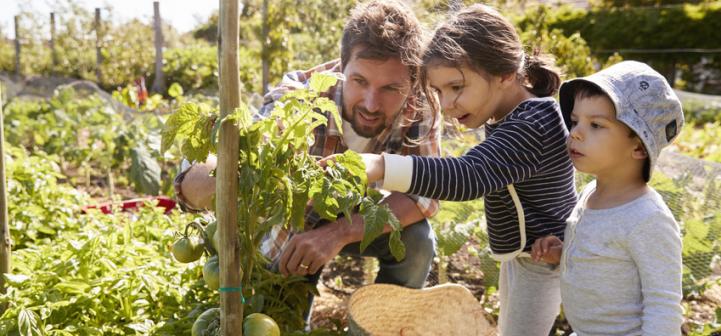
Building and maintaining a garden can seem like an expensive project, but with some careful planning, it doesn’t have to cost much at all. Whether you work with a school that could benefit from a garden or you are the parent that wants to start a garden at home or help start a garden at school, consider the following tips that will make gardening affordable.
1. Plan ahead
Careful planning can save a great deal of money by preventing the overbuying of seeds and tools. Think about what vegetables or herbs your school or family will enjoy, and stick to those5. Additionally, if you don’t own many tools, you can avoid buying some equipment by choosing plants that don’t require many tools to grow. The tools you will needs for basic gardening are a shovel, bucket, garden hose, rake and gloves. Potatoes, radishes, and kale are a few great vegetables that are simple to grow 2. Some herbs that are light on equipment needs include mint, lemon balm, thyme, rosemary, and sage. If you want to start off with plants that are even simpler, basil, coriander, parsley, and chili pepper are herbs that grow nicely in pots on a windowsill2. Check out this Kids Gardening Website and Growing Guide6 for further growing information, as well as this School, Community, & Home Gardening Resource Guide4 for additional resources.
Once you decide what you want to grow, carefully map out your garden so you know exactly how much you need to get your garden started.
2. Make friends who garden
Making friends who garden can extend your budget and make gardening more enjoyable. Before you shop, see if any friends have extra seeds, tools, or even space in their garden beds for you to share. If you are reluctant to start your own garden bed this season, see if sharing garden space with a neighbor is an option. Have seed swapping gatherings where fellow gardeners can bring extra seeds to swap and share, and help foster connections that will bring your garden community closer together.
3. Start with seeds, not seedlings
Seedlings can appear to be a convenient option, but you will get much more bang for your buck if you grow from seeds. For example, a pack of six lettuce seedlings will cost anywhere from $3 to $6, whereas a pack containing 500 lettuce seeds will cost less than $31. SNAP Benefits can be used for purchasing seeds as well. For plants that don’t grow well from seeds, you can ask your friends that garden if you can take a cutting from their already-grown plants. Simply cut a few pencil-width sticks from it, plant them in moist perlite and you should see roots and leaves start to grow within a few weeks to a few months1. Perlite is an amorphous volcanic glass that has a relatively high water content, typically formed by the hydration of obsidian. It occurs naturally and has the unusual property of greatly expanding when heated sufficiently. Most shrubs, many trees, and almost all perennials are easily grown from cuttings1. Learn more about growing from cuttings here3.
4. Buy used tools & get free ones too
One person’s trash is another person’s treasure. You can likely find many handy gardening tools at your local Re-Use center or at neighborhood garage sales. You can also try looking on Freecycle, a website where members of your local community can choose to give away things for free and where you can request items you are looking for2.
5. Grow organic
You can save money by avoiding chemical pesticides and fertilizers which may also be detrimental to you and your family’s health5. Compost works great as a natural fertilizer. To learn more about how to fertilize and protect your garden from insects, read Why Natural Insect Control Works Better and A Quick and Easy Guide to Homemade Organic Fertilizer5.
Contributors
Maya George and Tisa Hill, Cornell University, Division of Nutritional Sciences
Sources
1. Barth, Brian (2016). 10 Smart Ways to Garden on a Budget. Modern Farmer. Retrieved from https://modernfarmer.com/2016/02/gardening-ideas-on-a-budget/
2. (2012) Cheap Gardening Tips for Beginners: Saving and Making Money. Lovemoney. Retrieved from https://www.lovemoney.com/guides/539/cheap-gardening-for-beginners
3. (2017) How to Take Cuttings in 6 Easy Steps. The English Garden. Retrieved from http://www.theenglishgarden.co.uk/choice/how-to-take-cuttings-in-6-easy-…
4. (2013). School, Community & Home Gardening Resource Guide. Cornell Cooperative Extension Tompkins County. Retrieved from: https://s3.amazonaws.com/assets.cce.cornell.edu/attachments/1233/2013-g4…
5. Siegele, Lindsey (2010). Gardening on a Budget: 7 Tips for Success. Mother Earth News. Retrieved from: https://www.motherearthnews.com/organic-gardening/gardening-on-a-budget
6. Vegetable Growing Guides. Explore Cornell – Home Gardening – Introduction, Cornell University. Retrieved from: http://www.gardening.cornell.edu/homegardening/scene0391.html
